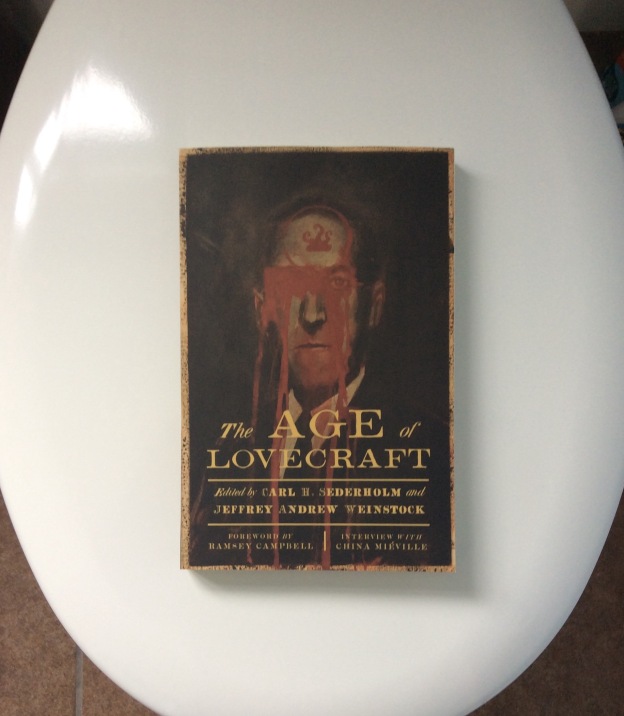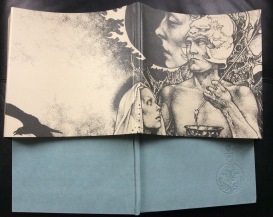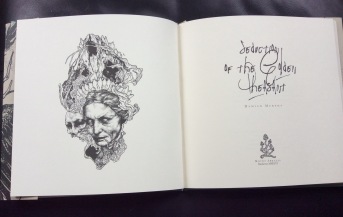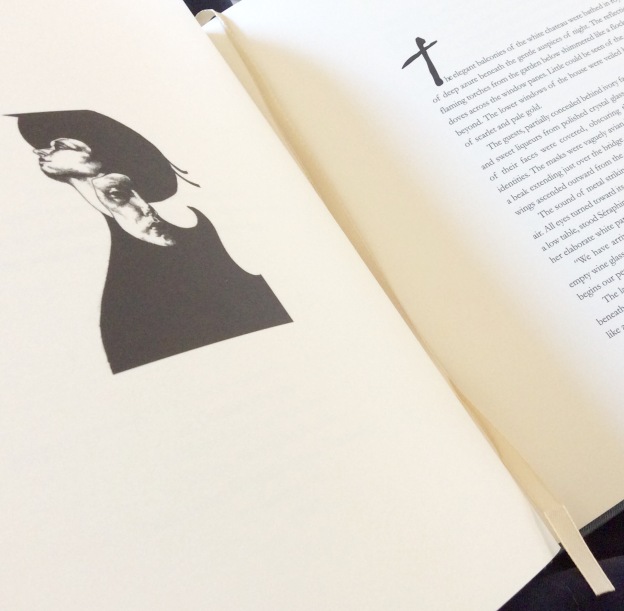
Edited by Ann and Jeff VanderMeer
Vintage Books 2016
My Real-Time Review of each story is currently being conducted HERE.
.
The Star - H. G. Wells
Sultana's Dream - Rokheya Shekhawat Hossein
The New Overworld - Paul Scheerbart
The Triumph of Mechanics - Karl Hans Strobl
Elements of Pataphysics - Alfred Jarry
Mechanopolis - Miguel de Unamuno
The Doom of Principal City - Yefim Zozulya
The Comet - W. E. B. Du Bois
The Fate of the Poseidonia - Clare Winger Harris
The Star Stealers - Edmond Hamilton
The Conquest of Gola - Leslie F. Stone
A Martian Odyssey - Stanley G. Weinbaum
The Last Poet and the Robots - A. Merritt
The Microscopic Giants - Paul Ernst
Tlön, Uqbar, Orbis Tertius - Jorge Luis Borges
Desertion - Clifford D. Simak
September 2005: The Martian - Ray Bradbury
Baby HP - Juan José Arreola
Surface Tension - James Blish
Beyond Lies the Wub - Philip K. Dick
The Snowball Effect - Katherine MacLean
Prott - Margaret St. Clair
The Liberation of Earth - William Tenn
Let Me Live in a House - Chad Oliver
The Star - Arthur C. Clarke
Grandpa - James H. Schmitz
The Game of Rat and Dragon - Cordwainer Smith
The Last Question - Isaac Asimov
Stranger Station - Damon Knight
Sector General - James White
The Visitors - Arkady and Boris Strugatsky
Pelt - Carol Emshwiller
The Monster - Gérard Klein
The Man Who Lost the Sea - Theodore Sturgeon
The Waves - Silvina Ocampo
Plenitude - Will Worthington
The Voices of Time - J. G. Ballard
The Astronaut - Valentina Zhuravlyova
The Squid Chooses Its Own Ink - Adolfo Bioy Casares
2 B R 0 2 B - Kurt Vonnegut Jr.
A Modest Genius - Vadim Shefner
Day of Wrath - Sever Gansovsky
The Hands - John Baxter
Darkness - André Carneiro
"Repent, Harlequin!" Said the Ticktockman - Harlan Ellison
Nine Hundred Grandmothers - R. A. Lafferty
Day Million - Frederik Pohl
Student Body - F. L. Wallace
Aye, and Gomorrah - Samuel R. Delany
The Hall of Machines - Langdon Jones
Soft Clocks - Yoshio Aramaki
Three from Moderan - David R. Bunch
Let Us Save the Universe - Stanisław Lem
Vaster Than Empires and More Slow - Ursula K. Le Guin
Good News from the Vatican - Robert Silverberg
When It Changed - Joanna Russ
And I Awoke and Found Me Here on the Cold Hill's Side - James Tiptree Jr.
Where Two Paths Cross - Dmitri Bilenkin
Standing Woman - Yasutaka Tsutsui
The IWM 1000 - Alicia Yánez Cossío
The House of Compassionate Sharers - Michael Bishop
Sporting with the Chid - Barrington J. Bayley
Sandkings - George R. R. Martin
Wives - Lisa Tuttle
The Snake That Read Chomsky - Josephine Saxton
Reiko's Universe Box - Kajio Shinji
Swarm - Bruce Sterling
Mondocane - Jacques Barbéri
Blood Music - Greg Bear
Bloodchild - Octavia E. Butler
Variation on a Man - Pat Cadigan
Passing as a Flower in the City of the Dead - S. N. Dyer
New Rose Hotel - William Gibson
Pots - C. J. Cherryh
Snow - John Crowley
The Lake Was Full of Artificial Things - Karen Joy Fowler
The Unmistakable Smell of Wood Violets - Angélica Gorodischer
The Owl of Bear Island - Jon Bing
Readers of the Lost Art - Élisabeth Vonarburg
A Gift from the Culture - Iain M. Banks
Paranamanco - Jean-Claude Dunyach
Crying in the Rain - Tanith Lee
The Frozen Cardinal - Michael Moorcock
Rachel in Love - Pat Murphy
Sharing Air - Manjula Padmanabhan
Schwarzschild Radius - Connie Willis
All the Hues of Hell - Gene Wolfe
Vacuum States - Geoffrey A. Landis
Two Small Birds - Han Song
Burning Sky - Rachel Pollack
Before I Wake - Kim Stanley Robinson
Death Is Static Death Is Movement - Misha Nogha
The Brains of Rats - Michael Blumlein
Gorgonoids - Leena Krohn
Vacancy for the Post of Jesus Christ - Kojo Laing
The Universe of Things - Gwyneth Jones
The Remoras - Robert Reed
The Ghost Standard - William Tenn
Remnants of the Virago Crypto-System - Geoffrey Maloney
How Alex Became a Machine - Stepan Chapman
The Poetry Cloud - Cixin Liu
Story of Your Life - Ted Chiang
Craphound - Cory Doctorow
The Slynx - Tatyana Tolstaya
Baby Doll - Johanna Sinisalo





 But this book’s author, whether the name is remembered or not, produces, for me, work that grows EVEN better and better the more I read of this author or the more this author writes new and newer works about these rarefied books that are created within such works. No exception here, as V receives a book (not the thing thieved by her, but freely borrowed from S’s chateau), a book that transliterates with the temples in her own chateau’s wallpaper. V is not a yellow wallpaper woman, but a woman far more destined to have thieved, with the arguably knowing nod of its owner, something I shall keep from you until you read THIS book that will entrammel something inside you, not your heart, soul or spirit, but something perhaps even more significant. You learn to handle these “logographic” things the more you read this author. And the more they actually handle you.
But this book’s author, whether the name is remembered or not, produces, for me, work that grows EVEN better and better the more I read of this author or the more this author writes new and newer works about these rarefied books that are created within such works. No exception here, as V receives a book (not the thing thieved by her, but freely borrowed from S’s chateau), a book that transliterates with the temples in her own chateau’s wallpaper. V is not a yellow wallpaper woman, but a woman far more destined to have thieved, with the arguably knowing nod of its owner, something I shall keep from you until you read THIS book that will entrammel something inside you, not your heart, soul or spirit, but something perhaps even more significant. You learn to handle these “logographic” things the more you read this author. And the more they actually handle you.
Please see first few entries on this Google search regarding my creative inspiration from HPL in the 1960s: HERE.
“…a rethinking of traditional philosophical vitalism that strips humanity of its exceptionalism and resituates it as the fragile product of cosmic coincidence.”
The first essay proper is:
GHOULISH DIALOGUES: HP Lovecraft’s Weird Geographies
by James Kneale (cultural and historical geographer at University College London.)
My review will continue in due course below….
“Since one purpose of this book is to reflect on the significance of Lovecraft’s increasing popularity, not to mention his marked impact on early twentieth-first-century discourse, we cannot dismiss the problem of racism as irrelevant, nor can we resolve it to everyone’s satisfaction.”
—————–
I have now read the first few pages of the James Kneale essay where we seem to be given permission to brainstorm upon HPL’s style and influence, where, just as one example, style awkwardness can lead to some sort of weird truth or insight (as my review above has ALREADY done!) i.e.:-
“The Age of Lovecraft might, in fact, be weirder than many of the fictions in his name.”
Weird style outweighing its weird content.
More later…
References to Poe, Miéville and Stross. And Graham Harman.
http://www.ligotti.net/showthread.php?t=10959
———–
The second essay is:
LOVECRAFT’S THINGS: Sinister Souvenirs from Other Worlds
By Jeffrey Andrew Weinstock (Professor of English at Central Michigan University.)
“It is much more complex than simple suspension of belief (or even disbelief). Horror fiction, at its best, enters our individual territories and becomes part and parcel of a revolving realm with Death at its core: and, in this realm, all the flotsam and jetsam of life (the richest life being generated by the imagination as well as by the day-to-day interaction of our minds and bodies) spin round, some colliding only to ricochet off, others sticking together, some being swallowed whole or bit by bit. Eventually, the various items are sucked into the core where they are minced up or refined into streams of sense (or apparent sense or, even, nonsense) which are then released from that realm into other revolving realms which create new collisions, fusions and spin-offs. This is using Death as a positive tool, as it surely is. Without Death, we’d be nothing.”
Above quoted from my blog here in 2006: http://weirdmonger.blogspot.co.uk/2006/04/free-fiction.html
HYPER-CACOPHONY: Lovecraft, Speculative Realism, and Sonic Materialism
By Isabella van Elferen (Professor of music and director of research for the School of Performance and Screen Studies at Kingston University London.)
This essay presents an impressively detailed litany of ‘unpleasant’ sound or music in the HPL fiction texts, in fact, for me, the major leitmotif in them. A gestalt that presents the infinite repercussions of dincopated infinity in, say, the “Ph’nglui…” incantation or refrain.
Mentions also Meillassoux.
I can now no longer question my lifelong love of HPL fiction texts and of music like Stockhausen, Schoenberg, Xenakis etc as well as the slightly more mellifluous Debussy, Glass, Messiaen, Beethoven late string quartets etc etc.
This essay has become a seminal slant on HPL, for me, and I shall revisit my real-time reviews where such references have permeated them since 2008 and my own reading since I first encountered HPL in 1964.
——————–
My past Dreamcatching Gestalt Real-time Reviews of Joshi associated books…
https://dflewisreviews.wordpress.com/2014/11/21/in-the-land-of-time-lord-dunsany/
https://dflewisreviews.wordpress.com/2014/08/30/the-dark-eidolon-and-other-fantasies-clark-ashton-smith/
https://dflewisreviews.wordpress.com/2015/01/07/bone-idle-in-the-charnel-house/
Classical Music Horror Anthology (2012)
PREHISTORIES OF POSTHUMANISM: Cosmic Indifferentism, Alien Genesis, and Ecology from H. P. Lovecraft to Ridley Scott
By Brian Johnson (associate professor and graduate chair of English at Carleton University)
More later…
I am sure others will find this essay fascinating, but since I have long suffered from ‘cinematic indifferentism’, I don’t think I am in a position to comment further on its comparisons with the films Alien and Prometheus.
RACE, SPECIES, AND OTHERS: H. P. Lovecraft and the Animal
By Jed Mayer (associate professor of Victorian literature at SUNY – New Paltz.)
More later…
And in the above context of its goal, this essay presents a telling perspective – from the HPL works and surrounding mores of the time, literature and scientific studies – of this knotty issue in HPL, including a fascinating reference to the tentacle’s arrival in the Gothic.
On a personal note, when I first read HPL in the 1960s, I knew nothing about the author, and I then felt not even a hint of this knotty issue. However, forced as I was to learn more about HPL in ensuing years, especially through his letters to Kleiner, I, too, was altered in my mindset towards his works. I suppose, with my interest, also from the 1960s, in Wimsatt’s Intentional Fallacy as a literary theory, I should not have allowed my mindset to have changed, but change it did.
Also, since writing my review above of Jed Mayer’s essay, this morning I had a minor operation on my neck’s long-term troublous sebaceous-cyst, and the surgeon lanced, drained and seaweed-dressing-packed it, while talking to me about its ‘tentacles’. Yes, that is the word he actually used! (Sometimes, I don’t believe myself!)
H. P. LOVECRAFT’S RELUCTANT SEXUALITY: Abjection and the Monstrousn Feminine in ‘The Dunwich Horror’
By Carl H. Sederholm (associate professor of humanities at Brigham Young University)
More later…
A refreshingly open-ended and exploratory essay, describing, inter alia, possible associations with his father’s death by syphilis, the “paradoxes of the body”, Lavinia Whateley’s imputed coupling with Yog Sothoth and Joshi’s apparent propensity, in his studies, not to pursue HPL’s sexual side, beyond reference to a possible low sex drive.
H. P. LOVECRAFT AND REAL PERSON FICTION: The Pulp Author as Subcultural Avatar
By Davud Simmons (senior lecturer in English and screen studies at Northampton University.)
More later…
A POLYCHROME STUDY: Neil Gaiman’s “A Study in Emerald” and Lovecraft’s Literary Afterlives
By Jessica George (PhD from Cardiff University)
More later…
“…that human identity may rely upon writing, but the identities we inhabit when we write, and when we rewrite by reading, are always multiple and partial.”
This remarkably seems to represent my long-term ethos of gestalt real-time reviewing, i.e. reader and author in mutual synergy, the two-way pecking order of author, narrator, characters and readers, a filter in both directions. The potential public triangulation of any work as it is hawled or dreamcaught through a myriad of real-time reviewers, Wimsatt’s Intentional Fallacy, Jungianism and more. As well as this essay being another revelation regarding the phenomenon that is Lovecraft. A unique name that only he and his family bears – as the final irony? A watershed for me, too.
By David Punter (Professor of English at the University of Bristol)
As well as this essay’s attempt to reconcile the paradox of its own aim to ‘prove’ the modernity of HPL texts despite their overt, presumably ‘intentional’, archaism, it also deals, as part of that reconciliation, with apophenia and pareidolia which two linked obsessions anyone reading my gestalt real-time book reviews will attest are fully present in me!
Paranoia, conspiracy, incantatory recurrencies like lists of forbidden books, a minimalist music or a French anti-novel?
Another watershed for me. I have ever considered HPL’s work ‘modern’ but never really addressed this point before. Thanks, Mr Punter.
I see that it can also relate to what I have long called Aickman’s ‘disarming strangenesses’ which in turn can be related to TS Eliot’s ‘objective correlatives’ (TSE being a writer I believe HPL did not like!)
My things about AICKMAN linked here: https://dflewisreviews.wordpress.com/robert-aickman/
Other possible related real-time reviews concerning works by Blackwood, Machen, Poe and John Cowper Powys:
https://dflewisreviews.wordpress.com/2015/01/19/ancient-sorceries-and-other-chilling-tales-by-algernon-blackwood/
https://dflewisreviews.wordpress.com/2015/03/04/the-three-impostors-arthur-machen/
https://dflewisreviews.wordpress.com/2015/04/20/tales-of-mystery-and-imagination-edgar-poe/
https://dflewisreviews.wordpress.com/2013/04/29/the-inmates-john-cowper-powys/
And other older or classic books triangulated by myself potentially relevant and linked from here:
https://dflewisreviews.wordpress.com/reviews-of-older-books/
By Patricia MacCormack (Professor of continental philosophy at Anglia Ruskin University, Cambridge)
“Against many critics, Lovecraft offers entryways into feminist, ecosophical, queer, and mystical (albeit atheist) configurations of difference. [.….] …to show that Lovecraft is uncannily relevant for posthuman philosophies, and that traditional criticisms of his work as nihilistic, misogynistic, unethical, and generally concerned with the maintenance of traditional values ought to be reoriented.”
I wonder if you will consider this essay meets with such a goal. I, for one, have found it impressive and compelling.
By W. Scott Poole (Professor of history at the College of Charleston)
This seems to me to be a bit of a balance to some of this book’s other brainstorming. Basing HPL’s racism on his interest (subsumption?) in witchcraft (as well as cosmic horror, great old ones etc). This article does not excuse but perhaps explains. What do you think? I find it less interesting from an Intentional Fallacy point of view, and prefer the hyper-cacophony, pareidolia and modernity side of the HPL texts, if not the personal side of HPL himself.
I do not usually carry out real-time reviews on anything but fiction, and I have tried, in this review, to draw out a texture rather than an acrimony. I may or may not have some skill in dreamcatching pure fiction, but I make no claims about reviewing academic literary-criticism, biography, history, philosophy, science, religion, sociology…
Attracts, repels and purges, yes, and it is a book that I can now remove from the lid of the biggest purging device of our civilisation called the Lavatory. It seems to conclusively disprove a contention I found someone making about academic studies of HPL in connection with this specific book: an on-line statement that academia “went completely into the toilet with postmodernist insanities like poststructuralism and deconstruction after the 1960s).” At least we can now purge that particular myth. I hope my fiction reviews utilise such methods, among many other methods new and old, to triangulate the books I buy to read.
Today’s Age of Lovecraft, derived from a prophetic sort of walking, breathing, complex, entangled Age of the Internet that is part of the same palimpsest. So, yes, the cosmic HPL HyPerLink attracts, repels, purges AND connects – for good and ill as humanity’s intrinsic nature that ever needs purging, laving, loving.
end